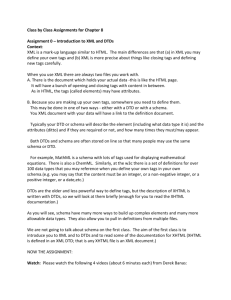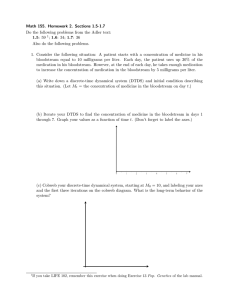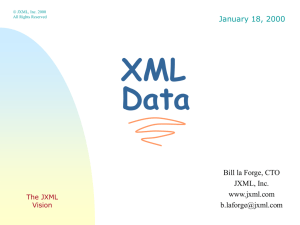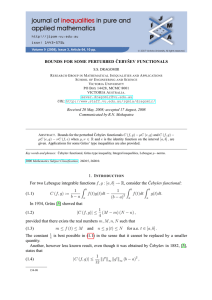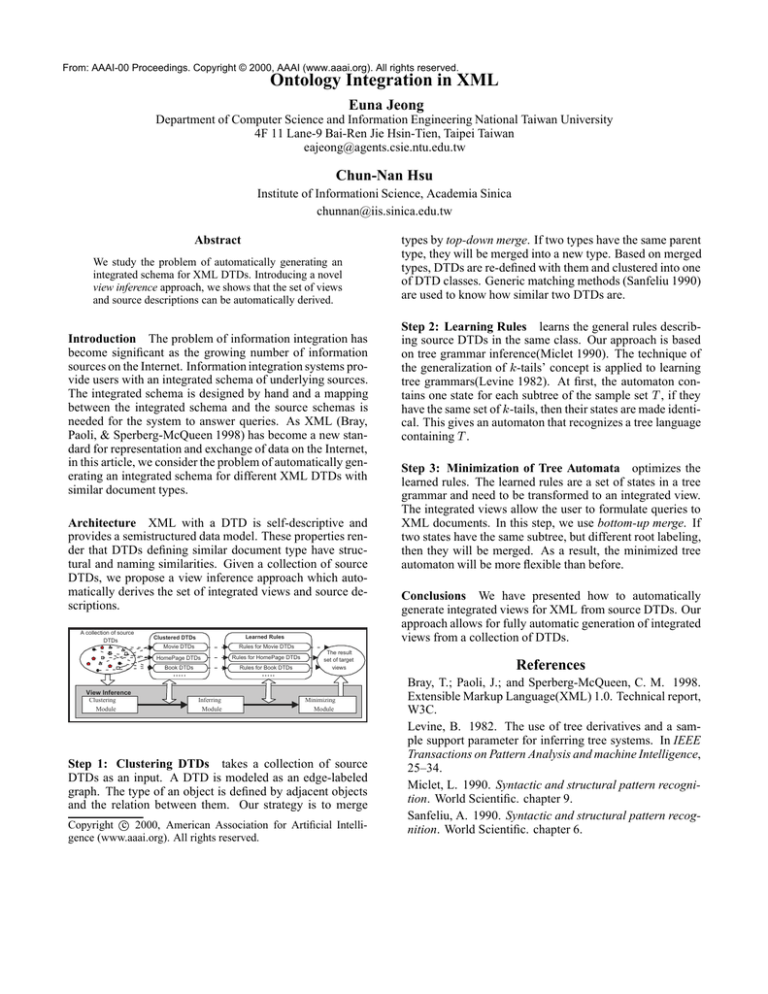
From: AAAI-00 Proceedings. Copyright © 2000, AAAI (www.aaai.org). All rights reserved.
Ontology Integration in XML
Euna Jeong
Department of Computer Science and Information Engineering National Taiwan University
4F 11 Lane-9 Bai-Ren Jie Hsin-Tien, Taipei Taiwan
eajeong@agents.csie.ntu.edu.tw
Chun-Nan Hsu
Institute of Informationi Science, Academia Sinica
chunnan@iis.sinica.edu.tw
Abstract
We study the problem of automatically generating an
integrated schema for XML DTDs. Introducing a novel
view inference approach, we shows that the set of views
and source descriptions can be automatically derived.
Introduction The problem of information integration has
become significant as the growing number of information
sources on the Internet. Information integration systems provide users with an integrated schema of underlying sources.
The integrated schema is designed by hand and a mapping
between the integrated schema and the source schemas is
needed for the system to answer queries. As XML (Bray,
Paoli, & Sperberg-McQueen 1998) has become a new standard for representation and exchange of data on the Internet,
in this article, we consider the problem of automatically generating an integrated schema for different XML DTDs with
similar document types.
Architecture XML with a DTD is self-descriptive and
provides a semistructured data model. These properties render that DTDs defining similar document type have structural and naming similarities. Given a collection of source
DTDs, we propose a view inference approach which automatically derives the set of integrated views and source descriptions.
,,
,
A collection of source
DTDs
Learned Rules
Clustered DTDs
Movie DTDs
Rules for Movie DTDs
HomePage DTDs
Rules for HomePage DTDs
Book DTDs
Rules for Book DTDs
.....
View Inference
Clustering
Module
.....
Inferring
Module
The result
set of target
views
Minimizing
Module
Step 1: Clustering DTDs takes a collection of source
DTDs as an input. A DTD is modeled as an edge-labeled
graph. The type of an object is defined by adjacent objects
and the relation between them. Our strategy is to merge
Copyright c 2000, American Association for Artificial Intelligence (www.aaai.org). All rights reserved.
types by top-down merge. If two types have the same parent
type, they will be merged into a new type. Based on merged
types, DTDs are re-defined with them and clustered into one
of DTD classes. Generic matching methods (Sanfeliu 1990)
are used to know how similar two DTDs are.
Step 2: Learning Rules learns the general rules describing source DTDs in the same class. Our approach is based
on tree grammar inference(Miclet 1990). The technique of
the generalization of k -tails’ concept is applied to learning
tree grammars(Levine 1982). At first, the automaton contains one state for each subtree of the sample set T , if they
have the same set of k -tails, then their states are made identical. This gives an automaton that recognizes a tree language
containing T .
Step 3: Minimization of Tree Automata optimizes the
learned rules. The learned rules are a set of states in a tree
grammar and need to be transformed to an integrated view.
The integrated views allow the user to formulate queries to
XML documents. In this step, we use bottom-up merge. If
two states have the same subtree, but different root labeling,
then they will be merged. As a result, the minimized tree
automaton will be more flexible than before.
Conclusions We have presented how to automatically
generate integrated views for XML from source DTDs. Our
approach allows for fully automatic generation of integrated
views from a collection of DTDs.
References
Bray, T.; Paoli, J.; and Sperberg-McQueen, C. M. 1998.
Extensible Markup Language(XML) 1.0. Technical report,
W3C.
Levine, B. 1982. The use of tree derivatives and a sample support parameter for inferring tree systems. In IEEE
Transactions on Pattern Analysis and machine Intelligence,
25–34.
Miclet, L. 1990. Syntactic and structural pattern recognition. World Scientific. chapter 9.
Sanfeliu, A. 1990. Syntactic and structural pattern recognition. World Scientific. chapter 6.



